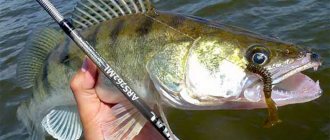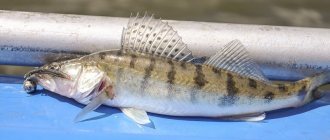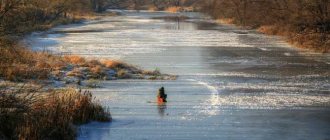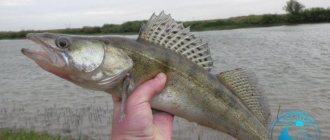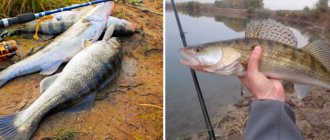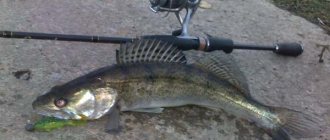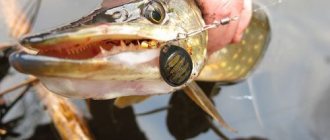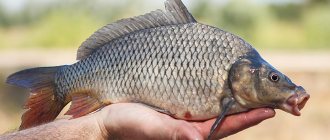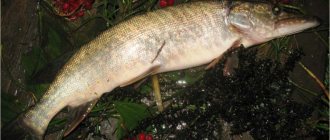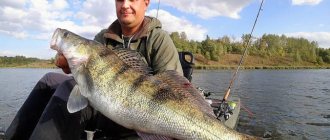What weather is best to catch pike perch?
Today we offer the topic: “what weather is best to catch pike perch” from professional fishermen. We tried to cover the topic as fully as possible. You can ask all questions in the comments after the article.
Pike perch is the treasured catch of any fisherman, because finding and hooking a fanged one is not so easy. Like any other fish, pike perch is very sensitive to weather changes, and its bite largely depends on weather conditions. What weather conditions should you give preference to when fishing for pike perch and is it worth going fishing on one day or another?
Pike perch does not tolerate heat and bright sun. If the sun shines for a long time and
then the sky becomes cloudy, then the pike perch begins to show noticeable activity.
It is practically useless to try to catch pike perch in a pond during the day, where the sun breaks through the layer of water to the very bottom. In such a reservoir, the pike perch will hide in cover and will be passive to baits. It has been noticed that the fanged predator bites well when the sun rises not from the horizon, but from behind the clouds. It’s similar in the evening, when the sun sets not behind the horizon, but behind the clouds.
In summer, pike perch are caught at night due to poor tolerance to heat and bright sunlight. In spring and fall, when water temperatures cool, walleye can be caught throughout the day in any weather.
Before the onset of a heavy wind or storm, the pike perch bite completely disappears; trying to catch it during this period is useless. It lies at the bottom before the onset of bad weather. If significant ripples are noticeable in a reservoir in windy weather, it makes sense to catch pike perch only in the bottom layers. In calm weather, pike perch can be in the surface layers of the reservoir.
I have been active fishing for quite some time and have found many ways to improve the bite. And here are the most effective:
- Bite activator. Attracts fish in cold and warm water with the help of pheromones included in the composition and stimulates its appetite. It’s a pity that Rosprirodnadzor wants to impose a ban on its sale.
- More sensitive gear. Reviews and instructions for other types of gear can be found on the pages of my website.
- Lures using pheromones.
You can get the rest of the secrets of successful fishing for free by reading our other articles on the site.
Like any other predator, pike perch is very sensitive to atmospheric pressure.
At low atmospheric pressure, the oxygen saturation in the water is low and the fish behave sluggishly, passively, and lie on the bottom. But this does not mean that the pike perch bite will be completely absent. There are chances of catching a fanged predator during such periods, although minimal. To do this, you need to use bottom wires and bright jig baits.
It is very convenient to plan future fishing using the weather forecast, namely information about cyclones and anticyclones. A cyclone is an area of low pressure, and an anticyclone is an area of high pressure. When air fields change, magnetic fields also change, to which fish react very sensitively. Depending on the presence of air masses over the fishing territory, there are several situations that are worth paying attention to:
- If the fishing area falls at the beginning of a cyclone, then the bite will be completely absent or very bad.
- After the center of the cyclone has passed the fishing territory, the bites will become more active and will be 2-3 times more frequent than at the beginning of the cyclone.
- If the fishing area is located in an anticyclone, then the bite should be excellent.
- If the fishing area is located between cyclones or anticyclones, then it is also necessary to look at the direction of the wind, and what this wind will bring in the future.
- If the fishing territory is located between two cyclones and two anticyclones, then the bite will be completely absent. This position of air fields is called a pressure saddle and is very rare. On such days there will be no bite, so it is better not to waste time fishing.
At what weather changes does pike perch begin to bite?
There are a number of signs that have been noticed by fishermen over a long period of time, and which with a high degree of probability make it possible to predict whether the pike perch will bite or not. Here are the most famous of them:
- if a strong wind rises at night after midnight, then catching a pike perch tomorrow is unlikely;
- if during the day the wind changes to the opposite direction, then the pike perch will not bite at that time;
- when in the summer it is hot for several days and a weak wind blows up to 2 m/s, then pike perch is caught well in the morning and evening twilight.
So, when going fishing for pike perch, it would be useful to look at the weather forecast for the days planned for fishing.
How weather conditions affect the pike perch bite in winter and summer
Pike perch is one of the predatory fish. In the summer, pike perch are most often caught using spinning rods, less often with girdles, donks, and mugs. In winter, pike perch are caught both actively: with balance beams, spoons, etc., and passively: with sprat, with pieces of fish...
The detained fishermen told the secret of how they managed to catch 237 kg of large fish, without prohibited equipment.
The detained fishermen told the secret of how they managed to catch 237 kg of large fish, without prohibited equipment.
However, in order to return home with a good catch, it is not enough to take into account only the bait and the technique of presenting this bait.
It is important to take into account a number of other factors that significantly affect the catch. Let's talk about them in more detail.
For quite a long time, there was an opinion that active fishing for pike perch lasts from May until late autumn. However, over time, the opinion of fishermen has changed radically, since under certain conditions favorable for pike perch, this fish can be successfully caught all year round.
The best periods for catching pike perch, however, are rightfully early spring and October. The choice of these periods is not accidental, since it is at this time that the water temperature is most favorable, as a result of which not only pike perch, but also pike and perch are active.
If we talk about weather conditions, it can be noted that pike perch lie on the bottom before a storm. That is why, if the forecast for the near future forecasts squally winds, heavy rain, hail, etc., then going fishing makes no sense, since the probability of returning home with a catch is almost zero.
In addition, take into account this interesting feature - if the sun shines brightly for several hours, and then the weather suddenly begins to slowly deteriorate, the sky becomes cloudy, then the pike perch, as a rule, begins to become more active.
The weather also affects how far the fish are from the surface of the water.
Pike-perch biting intensity per year
- If there is a strong wave, then there is a high probability that the fish will try to stay as deep as possible;
- If the water is calm, the weather is sunny, but there is no intense heat, then the pike perch may well be located at a distance not exceeding 1 meter from the surface of the water;
In addition, in favorable, comfortable weather, fish can also go to areas of the reservoir whose depth does not exceed 2 meters.
However, there is no point in fishing if the sun shines through the pond to the bottom. Under such weather conditions, you are unlikely to catch this predator, since it:
- Firstly, it does not like clear water;
- Secondly: the heat;
During the heat, the fish can find shelter in a sandbank not far from the shore, so it makes sense to try your luck there.
If we talk about the time of day, then we can say that pike perch takes bait well both at night and during the day. At dawn, small specimens are more likely to peck, while large ones go “hunting” mainly at dusk.
By the way, about favorable weather and atmospheric pressure for pike fishing ™ © - read here .
What atmospheric pressure is favorable for catching pike perch?
Note that increasing atmospheric pressure has a very beneficial effect on the predator’s appetite.
This is explained quite simply:
Having 13 years of fishing experience, I have learned many ways to return home with a rich catch. Here are the most effective:
- Bite activator. This additive with pheromones causes a wild appetite even in well-fed and passive fish, attracting them to the fishing spot from long distances. The Fish Hungry bite activator has proven itself to be excellent - more details.
- Gear with increased sensitivity. You should first familiarize yourself with the features of using a particular type.
- Pheromone lures. They attract the attention of fish, stimulate hunger and cause a schooling reflex, which allows you to collect a lot of fish in one place.
You can get the rest of the secrets of successful fishing for free by reading my other materials on the site.
Forecasting the pike perch bite based on atmospheric pressure
A cyclone is a micro-typhoon in our latitudes, or a hurricane of weak strength. With his arrival, the fish lies in anticipation of a storm, apparently laid down from ancient times. We observe only the external manifestations of a cyclone, such as cooling or warming, precipitation, and wind. There is no rain in the water, and the wind doesn’t bother you, but the bite sometimes varies greatly on seemingly similar days.
Apparently, during the interactions of cyclones and anticyclones, changes occur in the magnetic, electric, and possibly other, still unknown, fields of the Earth. Moreover, they occur within such insignificant limits that they have practically no effect on healthy people, but in old people “their bones ache” before bad weather.
Fish is even more sensitive, and it also has enough “bones,” and the concept of “bad weather” is associated with the arrival of a cyclone, or the entrance to a cyclone. Fronts accompanying cyclones, both warm and cold, negatively affect fish activity. It is interesting that the asp senses the approach of a cyclone earlier and actively hunts long before the weather breaks, while the reaction of pike perch is delayed by a day.
It also happens: Carp fishing by masters
Well, now, having information about how the pike perch bite depends on the location of the cyclones, let’s move on directly to the forecasting method. To do this you will need very little: a barometer, a TV and a little time. Instead of a TV, it is even better to have a computer with Internet access. Well, of course, you know where north, south, east and west are relative to your home.
First, you need to record the barometer readings at the moment and watch a television broadcast of the weather forecast (more or less accurate locations of cyclones and anticyclones are shown on NTV and sometimes on RTR, if the forecast is based on satellite photos). It is also necessary to note where the wind is blowing from in order to determine in whose zone of influence - a cyclone or an anticyclone - we are currently located.
A cyclone is an area of low pressure, usually colored blue or gray on maps, respectively, an anticyclone is an area of high pressure, indicated in orange or red. Weather forecasting websites often show animated satellite photos of the cyclone appearing as a mass of clouds rotating counterclockwise.
This must be remembered. There is no cloudiness in the anticyclone, and this area of high pressure rotates clockwise - let's remember this too. Now it is completely clear that when the anticyclone approaches Moscow from the west on the right side, one should expect northerly winds. As the anticyclone moves from west to east, the wind will weaken and the atmospheric pressure will increase until we find ourselves in its center.
And if the anticyclone does not change the direction of movement, then the pressure after passing the center will begin to fall, and we, having reached the rear part of the anticyclone, will expose our face to the southern wind. With a cyclone, everything is exactly the opposite: at the entrance there is a south wind (of course, if the cyclone comes at us from the west, as in Fig.
By checking the weather forecast data with changes in the readings of your barometer needle and the direction and strength of the wind, you can quite accurately determine where we are in the cyclone or anticyclone. It is very important not to miss the moment when their movement is shown on the screen (usually a few seconds) in order to predict their combination and interaction for the next couple of days in advance. You can ignore the air temperature, and daily observations of changes in the atmosphere are sometimes very fascinating.
Evgeniy Avdonin: Meteor dependence of pike perch
Does the pike perch bite depend on the weather? And if it depends, then how? Knowing the correct answers to these questions will allow you to plan a fishing trip with the highest probability of catching pike perch. There are a lot of different theories explaining the dependence of pike perch on atmospheric processes, sometimes these theories fundamentally contradict each other. Which one should you follow? The answer is simple: practical experience will trump all theories. The author of this article, Evgeny Avdonin from the city of Gorodets, Nizhny Novgorod region, spends an average of 270 days a year on the river with a spinning rod. Many years of experience in catching pike perch from a boat using jig baits allowed him to conclude that of all meteorological processes, the dynamics of interaction between cyclones and anticyclones has a decisive influence on the activity of pike perch.
At the beginning of the article, we should immediately make a reservation that the pike perch bite itself varies greatly depending on the time of year and other factors, but I will only touch on the influence of weather conditions on it.
Typically, fishermen associate fish bite with concepts that are closest to them, such as air temperature, wind direction, precipitation, and moon phase. In my opinion, these factors are more noticeable in our habitat, and not in the aquatic environment, although everything in nature is interconnected and both environments have some influence on each other. However, in fact, the most significant impact on the well-being and, naturally, the activity of pike perch is exerted by the processes occurring during the interaction of cyclones and anticyclones. I came to this conclusion by analyzing the results of my fishing trips over the past few years.
